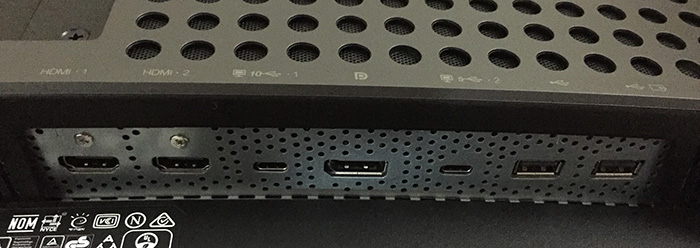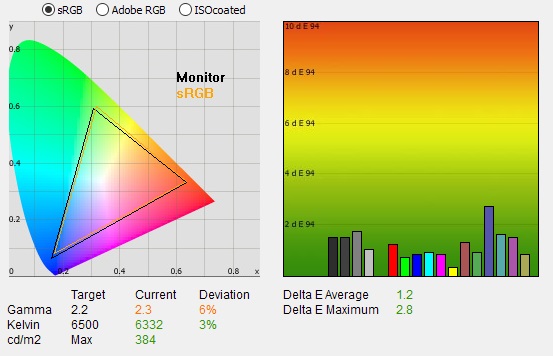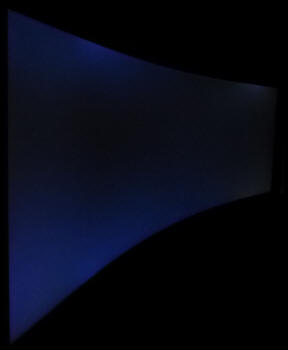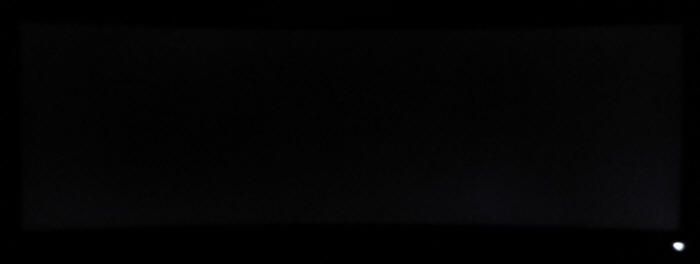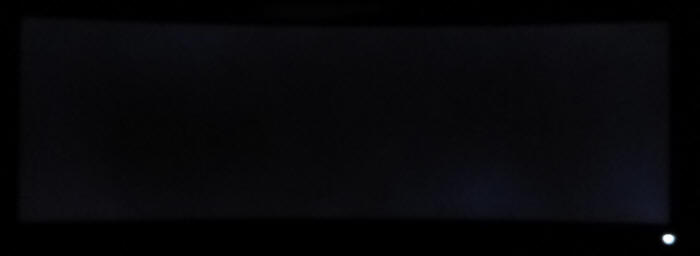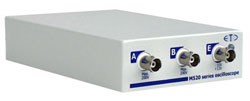|
|
||||
|
||||
|
|
|
||||||||||||||||||||||||||||||||||||||||||||||||||||||||||||||||||||||||||||||||||||||||||||||||||||||||||||||||||||||||||||||||||||||||||||||||||||||||||||||||||||||||||||||||||||||||||||||||||||||||||||||||||||||||||||||||||||||||||||||||||||||||||||||||||||||||||||||||||||||||||||||||||||||||||||||||||||||||||||||||||||||||||||||||||||||||||||||||||||||||||||||||||||||||||||||||||||||||||||||||||||||||||||||||||||||||||||||||||||||||||||||||||||||||||||||||||||||||||||||||||||||||||||||||||||||||||||
|
Monitor Specifications |
|||
|
Size |
43.4" |
Panel Coating |
Light AG coating |
|
Aspect Ratio |
32:10 super wide |
Interfaces |
1x DisplayPort 1.4
2x HDMI 2.0 |
|
Resolution |
3840 x 1200 |
||
|
Pixel Pitch |
0.274mm |
Design colour |
Matte black bezels and enclosure with black aluminium stand. Some small areas of blue trim in places |
|
Response Time |
4ms G2G |
Ergonomics |
Tilt, 130mm height, swivel |
|
Static Contrast Ratio |
3000:1 |
||
|
Dynamic Contrast Ratio |
3 million:1 |
VESA Compatible |
Yes 100 x 100 mm |
|
Brightness |
380 cd/m2 |
Accessories |
DisplayPort, HDMI and power cables. USB A > C and USB C > C cables. Detachable Harman Kardon certified speaker |
|
Viewing Angles |
178 / 178 |
||
|
Panel Technology |
Samsung SVA (VA-type) |
Weight |
with stand: 13.33 Kg |
|
Backlight Technology |
LED |
Physical Dimensions (WxHxD) |
1058.3 x 461.1 x 313.5 mm |
|
Colour Depth |
1.07b (8-bit + FRC) |
||
|
Refresh Rate |
144Hz |
Special Features |
AMD FreeSync 2, G-sync support, Detachable Harman Kardon certified speaker, PiP and PbP |
|
Colour Gamut |
Wide gamut 90% DCI-P3 |
||
The Y44w offers a good range of modern connectivity with 1x DisplayPort 1.4, 2 x HDMI 2.0 and 2x USB type-C offered for video connections. These are located on the back of the screen along with 2x downstream USB 3.1 ports. There are then a further 2x USB ports and a headphone output in a "hidden" pop out section on the bottom edge of the screen as shown below:

For PC connectivity the DisplayPort is the most common option, with HDMI being available then for connecting external games consoles or Blu-ray players potentially. Both will support variable refresh rates from AMD graphics cards or games consoles. From NVIDIA cards you can only use VRR over DisplayPort.
The screen has an internal power supply and comes packaged with the power cable that you need. a detachable Harman Kardon speaker as well which sits at the bottom of the stand and can be seen in many of the images provided in this review.
Below is a summary of the features and connections of the screen.
|
Feature |
Yes / No |
Feature |
Yes / No |
|
Tilt adjust |
|
DVI |
|
|
Height adjust |
|
HDMI |
|
|
Swivel adjust |
|
USB type-C |
|
|
Rotate adjust |
|
DisplayPort |
|
|
VESA compliant |
|
Component |
|
|
USB 2.0 Ports |
|
Audio connection |
|
|
USB 3.0 Ports |
|
HDCP Support |
|
|
Card Reader |
|
Integrated Speakers |
|
|
Ambient Light Sensor |
|
PiP / PbP |
|
|
Human Motion Sensor |
|
Blur Reduction Mode |
|
|
Touch Screen |
|
NVIDIA G-Sync (native) |
|
|
Factory calibration |
|
AMD FreeSync |
|
|
Hardware calibration |
|
G-sync Compatible Certified |
|
|
Uniformity correction |
|
Meaningful HDR |
|

Design and
Ergonomics
The Y44w comes in a mostly black design, with matte plastics used for the bezel and rear enclosure. There is a light grey "Legion" logo in the middle of the bottom bezel, and some grey logos on the bottom right hand area where the OSD control buttons are located. There is a 3-side borderless design on this screen with a thin 2mm plastic edge along the sides and top. There is also a black inner panel border which measures ~8.5mm along the sides, and 7.5mm along the top. The bottom of the screen has a thicker 25mm plastic bezel, and a small 2mm additional black panel border before the image starts.

Above: rear view of the screen.
Click for larger versions
The back of the screen is encased in a matte black plastic, with some grilled mesh areas in the central area as you can see above. The screen looks quite nice from the rear as well we thought. The stand attaches via a quick release mechanism, and behind that there are also VESA 100mm mounting holes if you'd rather. There's a useful carry handle above the stand attachment too and a detachable cable tidy clip on the back of the arm. The arm and foot are a sturdy black aluminium providing a very solid and stable base for the large screen.

Above: top
down view. Click for larger version
The stand is a V shape as you can see from the above image with some circular cut-out design patterns. There are some small areas of blue trim within the circular cut-outs and also along the bottom edge of the foot. The foot is very sturdy but looks quite industrial we thought. Maybe not to everyone's taste.

Above: side
view. Click for larger version
From the side the screen you can see that the Y44w has quite a deep stand and appearance because of the curved screen format.
The stand offers a good range of ergonomic adjustments. Tilt provides a wide range of adjustment but although it's smooth to operate, it's quite stiff. Height is also smooth but quite stiff, and provides a wide adjustment range as well. At the lowest setting the bottom edge of the screen is 110mm from the desk, but at maximum extension it's 240mm. This is actually a very high viewing position, but it does provide you a decent 130mm adjustment range for the height adjustment. Side to side swivel is smooth and easy to move, and there is no rotation function offered here as it would be massively impractical on a screen this wide and with a curved format anyway. The screen remains very stable when you are moving it around thanks to the very solid stand and sturdy base.
A summary of the ergonomic adjustments are shown below:
|
Function |
Range |
Smoothness |
Ease of Use |
|
Tilt |
Yes |
Smooth |
A little stiff |
|
Height |
130mm |
Smooth |
A little stiff |
|
Swivel |
Yes |
Smooth |
Easy |
|
Rotate |
No |
- |
- |
|
Overall |
Good range of adjustments and all pretty easy and smooth to move. Screen remains very stable |
||
The materials were of a good standard and the build quality felt solid and heavy duty. There was no audible noise from the screen, even when conducting specific tests which can often identify buzzing issues. The whole screen remained cool even during prolonged use.
The back of the screen features the connections which include 2x HDMI 2.0, USB type-C, DisplayPort 1.4, another USB type-C and 2x USB 3.0 downstream ports. There are an additional 2x USB ports and a headphone jack in the hidden pop out section on the bottom edge of the screen as shown below. We found this a bit fiddly to pop back in as it requires a fairly firm press up to latch it back in place. Not the smoothest mechanism.

The OSD is controlled through a series of 5 pressable buttons located on the front bottom right edge of the screen. There is quick launch access to the game preset menu (shown below), input selection, light balance and brightness controls.

The main menu is split in to 5 sections down the left hand side with available options shown in the middle column. If you then enter one of those sections, the available configuration options are shown on the right hand side column.



There is a good range of options available. Navigation was quick but a little fiddly sometimes to figure out which button selected an option, and which one then exited back a level.

Power Consumption
|
|
|
We have plotted these results below compared with other screens we have tested. The consumption (comparing the calibrated states) is comparable to the other large 37 - 43" sized screens we've tested, and not really much different to the wide range of 34 - 35" ultrawide models.


Panel and Backlighting
|
|
|||||||||||||||||||||||||||||
Panel Part and Colour Depth
The Y44w features an Samsung SVA LSM434YP01 (VA-type) technology panel. The panel offers 1.07 billion colours using an 8-bit + FRC colour depth. You do need to consider whether you're going to actually be able to use the 10-bit colour depth in real use. Whether or not you can make use of this 10-bit colour depth depends on your graphics card and applications although many consumer gaming graphics card will be able to use it for modern games and HDR. You would need a high end professional grade graphics card to make use of 10-bit in pro applications like Photoshop though.
Screen
Coating
The screen coating is a light anti-glare (AG) offering. It isn't a semi-glossy coating, like some older generation VA panels and is similar to other recent VA screens we've tested. Thankfully it isn't a heavily grainy coating like some much older IPS panels feature, and is also lighter than modern TN Film panel coating. It retains its anti-glare properties to avoid too many unwanted reflections of a full glossy coating, but does not produce too grainy or dirty an image that some thicker AG coatings can.
Backlight Type and Colour Gamut
The screen uses an LED backlight unit which is standard in today's market. This helps reduce power consumption compared with older CCFL backlight units and brings about some environmental benefits as well. The LED unit here offers a wider colour gamut which according to the spec covers 90% of the DCI-P3 gamut. There is also a working emulation support for the smaller sRGB colour space which is very useful. If you want to read more about colour spaces and gamut then please have a read of our detailed article.
We verified that the backlight is dimmed using a direct current (DC) method as opposed to PWM, and so is flicker free as advertised. The oscillograph at our calibrated settings is included below for reference. Note: should a screen ever show PWM behaviour we would include more detailed analysis in this section.
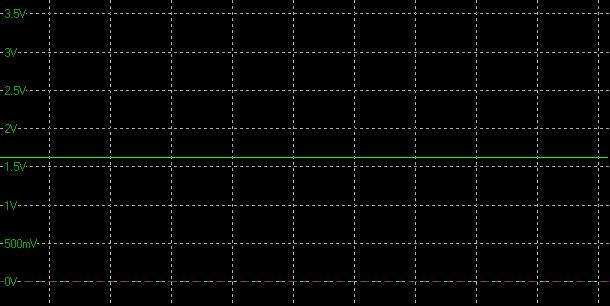

Brightness
and Contrast
This section tests the full range of luminance (the brightness of the screen) possible from the backlight, while changing the monitors brightness setting in the OSD menu. This allows us to measure the maximum and minimum adjustment ranges, as well as identify the recommended setting to reach a target of 120 cd/m2 for comfortable day to day use in normal lighting conditions. Some users have specific requirements for a very bright display, while others like a much darker display for night time viewing or in low ambient light conditions. At each brightness level we also measure the contrast ratio produced by the screen when comparing a small white sample vs. a black sample (not unrealistic full screen white vs. full screen black tests). The contrast ratio should remain stable across the adjustment range so we also check that.
Graphics card settings were left at default with no ICC profile or calibration active. Tests were made using an X-rite i1 Display Pro Plus colorimeter. It should be noted that we used the BasICColor calibration software here to record these measurements, and so luminance at default settings may vary a little from the LaCie Blue Eye Pro report you will see in other sections of the review.
|
OSD Brightness |
Luminance |
Black Point (cd/m2) |
Contrast Ratio |
|
100 |
443.21 |
0.23 |
1927 |
|
90 |
410.08 |
0.21 |
1953 |
|
80 |
376.49 |
0.19 |
1982 |
|
70 |
342.26 |
0.17 |
2013 |
|
60 |
307.35 |
0.16 |
1921 |
|
50 |
273.48 |
0.14 |
1953 |
|
40 |
236.98 |
0.12 |
1975 |
|
30 |
199.66 |
0.10 |
1997 |
|
20 |
161.37 |
0.08 |
2017 |
|
10 |
122.24 |
0.06 |
2037 |
|
0 |
82.04 |
0.04 |
2051 |
|
Total Luminance Adjustment Range (cd/m2) |
361.17 |
Brightness OSD setting controls backlight |
|
|
Total Black Point Adjustment Range (cd/m2) |
0.19 |
||
|
Average Static Contrast Ratio |
1984:1 |
PWM Free |
|
|
Recommended OSD setting for 120 cd/m2 |
10 |
At the full brightness setting in the OSD the maximum luminance reached a very high 443 cd/m2 which was basically in line with the spec from the manufacturer. There was a pretty decent 361 cd/m2 adjustment range in total, so at the minimum setting you could reach down to a luminance of 82 cd/m2. This doesn't afford you a super-low luminance option for working in darkened room conditions with low ambient light however so be a little wary if that is a specific requirement for you. A setting of 10 in the OSD menu should return you a luminance of around 120 cd/m2 at default settings. It should be noted that the brightness regulation is controlled without the need for Pulse Width Modulation for all brightness settings so the screen is flicker free.


We have plotted the luminance trend on the graph above. The screen behaves as it should in this regard, with a reduction in the luminance output of the screen controlled by the reduction in the OSD brightness setting. This is a linear relationship.
The average contrast ratio of the screen was measured at a high 1984:1 thanks to the VA panel. This is one of the strengths of this technology for sure. This was a fair bit lower than the specified 3000:1 though, and is impacted by the poorly configured gamma curve (see the following section). Remember these measurements were carried out at default settings, so we will see if we can calibrate the screen to achieve a better contrast ratio at all later on.

Testing
Methodology
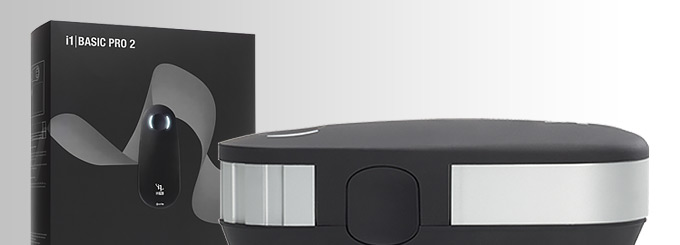
An important thing to consider for most users is how a screen will perform out of the box and with some basic manual adjustments. Since most users won't have access to hardware colorimeter tools, it is important to understand how the screen is going to perform in terms of colour accuracy for the average user.
We restored our graphics card to default settings and disabled any previously active ICC profiles and gamma corrections. The screen was tested at default factory settings using our new X-rite i1 Pro 2 Spectrophotometer combined with LaCie's Blue Eye Pro software suite. An X-rite i1 Display Pro Plus colorimeter was also used to verify the black point and contrast ratio since the i1 Pro 2 spectrophotometer is less reliable at the darker end.
Targets for these tests are as follows:
-
CIE Diagram - confirms the colour space covered by the monitors backlighting in a 2D view, with the black triangle representing the displays gamut, and other reference colour spaces shown for comparison. Usually shown as a comparison against the common sRGB space
-
Colour space coverage volumes - we also measure using a piece of software called ChromaPure the colour space (gamut) volumes produced by the backlight in comparison to the sRGB, DCI-P3 and Rec.2020 colour spaces. sRGB is the most commonly used colour space so it is important to have a decent coverage from the screen here. If the colour space is >100% sRGB then the screen can produce a wider colour gamut, often reaching further in to the wider gamut DCI-P3 (commonly used for HDR) and Rec.2020 reference spaces.
-
Gamma - we aim for 2.2 which is the default for computer monitors
-
Colour temperature / white point - we aim for 6500k which is the temperature of daylight
-
Luminance - we aim for 120 cd/m2, which is the recommended luminance for LCD monitors in normal lighting conditions
-
Black depth - we aim for as low as possible to maximise shadow detail and to offer us the best contrast ratio
-
Contrast ratio (static) - we aim for as high as possible. Any dynamic contrast ratio controls are turned off here if present
-
dE average / maximum - we aim for as low as possible. If DeltaE >3, the color displayed is significantly different from the theoretical one, meaning that the difference will be perceptible to the viewer. If DeltaE <2, LaCie considers the calibration a success; there remains a slight difference, but it is barely undetectable. If DeltaE < 1, the color fidelity is excellent.

Default Performance
and Setup
Default settings of the screen were as follows:
|
Lenovo
Legion Y44w-10
|
|
|||||||||||||||||||||||||||
|
|
Initially out of the box the screen was set with the 'Default' preset as it's called. The display was set with a very bright 80% brightness which was uncomfortable to use for long periods. You will want to turn that down. The colour balance felt fairly good, maybe a little warm. You could tell the screen offered a wider colour gamut as colours looked more vivid and bright than a standard sRGB gamut screen. We went ahead and measured the default state with the i1 Pro 2. The CIE diagram on the left of the image confirms that the monitors colour gamut (black triangle) extends a fair bit beyond the sRGB reference space (orange triangle), mostly in green and red shades. We measured using ChromaPure software a 122.0% sRGB gamut volume coverage which corresponds to 89.9% of the DCI-P3 reference (basically spot on to the advertised 90% coverage) and 64.5% of the Rec.2020 reference. There is an sRGB emulation mode available as well which we will test in a moment. The wide gamut does help create more vivid and bright colours for gaming, multimedia and HDR content. Default gamma was recorded at 2.7 average with a large 23% overall deviance from the target which was a bit of a problem. This will need correcting via a calibration device or by using one of the other preset modes as there are no specific gamma settings available in the OSD menu. |
|
Improving Gamma
We did test the gamma in each of the other preset modes like FPS, Racing and RTS and could not improve the curve any closer to 2.2. Most of those game modes are just set up the same as the 'Default' mode except with the ability to preset the brightness, contrast, overdrive and colour saturation controls in each. The colour saturation is set differently out of the box in each mode, for instance set at 80 instead of the default 50 in FPS1, creating a far more vivid and saturated image. So the game preset modes have no effect on the gamma curve sadly.
You can also stick with the 'Default' game mode and then change the 'color preset' mode if you want. The default is "reddish" as measured above. The other modes like 'neutral', 'bluish' and 'custom' will change the white point/colour temperature, but do not really impact the gamma at all. The BT.709 mode improves it a little down to 2.5 average, and the sRGB mode improves it even further to 2.3 average (measured in more detail below). So this is really the only way to improve the gamma curve without a calibration tool. The sRGB mode does provide a more reliable out of the box setup for day to day usage and any colour critical work.
Colour Temperature
White point was measured
at 6178k, being only a small 5% too warm which good news in the 'reddish' mode. We did also measure
the 'neutral' (6955k) and bluish (9301k) color modes for completeness. There is also a 'custom'
mode available in the menu where you have access to the RGB channels which will
be useful for calibration shortly. By default that mode did have a better white
point of 6473k, and was also brighter at 430 cd/m2 as all RGB
channels were defaulted to 100.
Luminance at the default 80% brightness level was recorded at a very bright 369 cd/m2 which is too high for prolonged general use, you will need to turn that down. The black depth was 0.19 cd/m2 at this default brightness setting, giving us a strong static contrast ratio of 1982:1 thanks to the VA panel technology used. Colour accuracy measurements should be ignored here as they are comparing the produced wider gamut display colours against an sRGB reference which will always lead to errors. The major gamma deviance also causes problems here with colour accuracy. When testing the screen with colour gradients there was some noticeable stepping and banding in darker shades which only seemed to get worse if you change to the other preset modes like FPS, Racing and RTS.
![]()
We also tested the screen in the sRGB preset mode:
|
Lenovo
Legion Y44w-10
|
|
|||||||||||||||||||||||||||
|
There is an sRGB emulation mode available via the 'Color preset mode' menu. Oddly when you enable this mode it locks the brightness and contrast controls, but not to any pre-defined level. It just locks them at whatever you had them set to before in the default mode! So the results shown above are based on the screen's default 80% brightness setting which is then locked to that level when you switch to the sRGB preset. You have to switch back to one of the other modes if you want to change the brightness to something else, before going back to the sRGB mode again afterwards. This is a bit odd, as it would have been handy if you could change the brightness control direct from within this mode, but at least it is possible to change the brightness when using the sRGB mode if you want. The same goes for some of the other modes incidentally like the DCi-P3 mode which basically offered the same gamut as the default mode (~90% DCI-P3).
In this sRGB preset mode you can see that the smaller colour gamut is being emulated nicely from the CIE diagram on the left. This cuts down nearly all the over-coverage and resulted in a 98.5% sRGB coverage. Gamma was also better in this mode at 2.3, leaving a smaller 6% deviance from our target. While point was also a little closer to 6500k at 6332k (3% deviance). The contrast ratio was also a bit higher now at 2263:1. We could also consider the dE figures in this mode which showed a very good colour accuracy of 1.2 average. There was still some banding and stepping in darker shades on gradients though, so despite the improved colour accuracy and gamma, we would advise caution using this screen for any colour critical work, or content where there are lots of gradients or solid areas of colour.
We used the X-rite i1 Pro 2 Spectrophotometer combined with the LaCie Blue Eye Pro software package to achieve these results and reports. An X-rite i1 Display Pro Plus colorimeter was used to validate the black depth and contrast ratios due to lower end limitations of the i1 Pro device.
|
Lenovo
Legion Y44w-10
|
|
|||||||||||||||||||||||||||
|
The OSD settings were adjusted as shown in the table above, as guided during the calibration process and measurements. These OSD changes allowed us to obtain an optimal hardware starting point and setup before software level changes would be made at the graphics card level. We left the LaCie software to calibrate to "max" brightness which would just retain the luminance of whatever brightness we'd set the screen to, and would not in any way try and alter the luminance at the graphics card level, which can reduce contrast ratio. These adjustments before profiling the screen would help preserve tonal values and limit banding issues. After this we let the software carry out the LUT adjustments and create an ICC profile.
Calibration of the screen with a calibration device allowed for a proper correction of the gamma curve, resulting now in an average 2.2 and sorting out the large 23% deviance we'd seen at default settings. The white point was also now corrected to 6517k which was great news. The brightness control adjustment had reduced the luminance to a comfortable level now, and the screen maintained a strong and slightly improved static contrast ratio of 2377:1 thanks to the VA panel. Colour accuracy of the resulting profile was good, with dE average of 0.7 and maximum of 1.4. LaCie would consider colour fidelity to be very good overall. Gradients improved a bit thanks to the corrected gamma, but there was still some moderate banding in darker shades.
You can use our settings and try our calibrated ICC profile if you wish, which are available in our ICC profile database. Keep in mind that results will vary from one screen to another and from one computer / graphics card to another.

Setup Comparisons
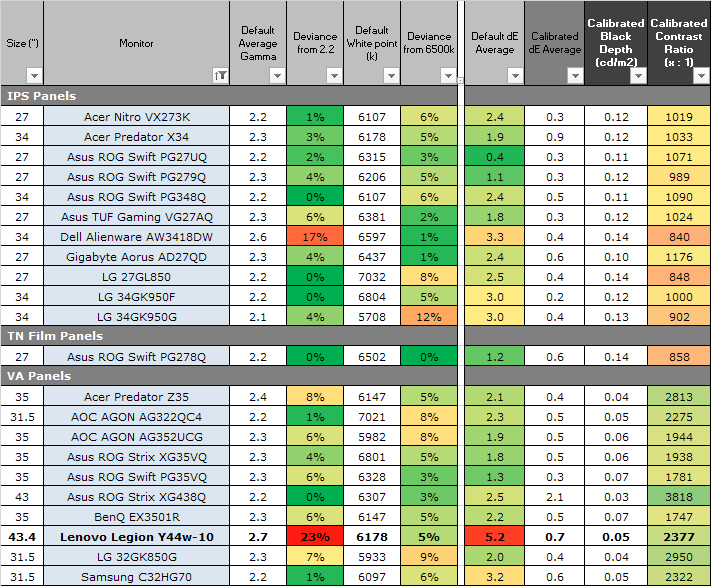
The comparisons made in this section try to give you a better view of how each screen performs, particularly out of the box which is what is going to matter to most consumers. We have divided the table up by panel technology as well to make it easier to compare similar models. When comparing the default factory settings for each monitor it is important to take into account several measurement areas - gamma, white point and colour accuracy. There's no point having a low dE colour accuracy figure if the gamma curve is way off for instance. A good factory calibration requires all 3 to be well set up. We have deliberately not included luminance in this comparison since this is normally far too high by default on every screen. However, that is very easily controlled through the brightness setting (on most screens) and should not impact the other areas being measured anyway. It is easy enough to obtain a suitable luminance for your working conditions and individual preferences, but a reliable factory setup in gamma, white point and colour accuracy is important and some (gamma especially) are not as easy to change accurately without a calibration tool.
From these comparisons we can also compare the calibrated colour accuracy, black depth and contrast ratio. After a calibration the gamma, white point and luminance should all be at their desired targets.
Default setup of the screen out of the box
was poor overall to be honest, and clearly aimed more at gaming than any day to
day work or colour critical applications. That is the target market for this
screen though to be fair. The main issue was the really high gamma, measured at
2.7 and leaving a large 23% deviance from our target. This was also hard to
correct without any gamma settings in the OSD menu, and the only way to really
improve it without a calibration device was to switch to the sRGB color mode.
Thankfully that mode worked well and provides a reliable sRGB emulation and good
colour accuracy with low dE. White point was reasonable out of the box and a bit
easier to correct and customise with the available modes and customisable RGB
channels.
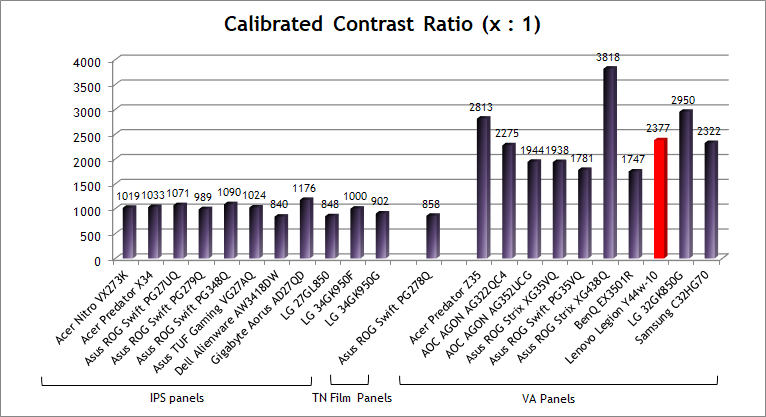
The contrast ratio was strong thanks to the VA panel, measured at 2377:1 after calibration. This was much higher than you can achieve from competing IPS and TN Film panels, but a bit lower than some other VA models we've tested in the past.
|
Check Pricing and Buy - Affiliate Links |
|
TFTCentral is a participant in the Amazon Services LLC Associates Programme, an affiliate advertising programme designed to provide a means for sites to earn advertising fees by advertising and linking to Amazon.com, Amazon.co.uk, Amazon.de, Amazon.ca and other Amazon stores worldwide. We also participate in a similar scheme for Overclockers.co.uk. |

Viewing Angles
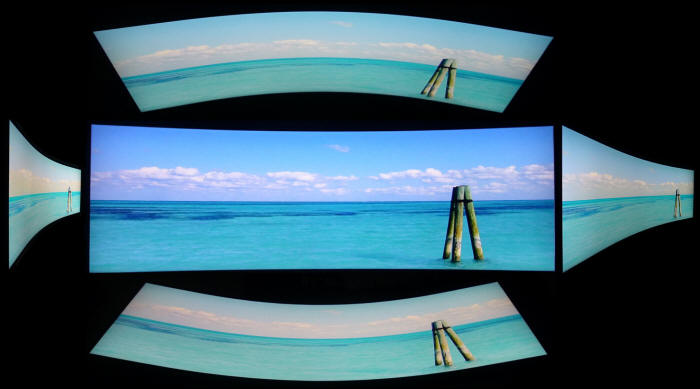
Above: Viewing angles shown from front and side, and from above and below.
Click for larger version
Viewing angles of the screen were good overall, and better than many modern VA panels we've tested in fact. Only from a very wide side angle did the image became washed out and pale in appearance as you can see. This was better than quite a few other recent VA screens we've tested which showed a more pale image with narrower angles. Vertically the washout was a little more pronounced but still not bad at all. The Y44w with its Samsung VA panel had better viewing angles than recent models featuring AU Optronics AMVA panels like the Asus ROG Swift PG35VQ and Asus ROG Strix XG438Q for instance. These strong viewing angles were very beneficial on a screen as large and as wide as this, helping to avoid unwanted colour and gamma shift as you look towards the edges of the screen, which are quite a long way away from your central viewing position. There were no issues here. The curve of the screen was also useful in this area, again given the very wide field of vision. The colour tone and gamma shifts were still a bit more noticeable than IPS-type panels though.
Users should also be aware that the panel exhibits the off-centre contrast shift which is inherent to the VA pixel structure. When viewing a very dark grey font for example on a black background, the font almost disappears when viewed head on, but gets lighter as you move slightly to the side. This is an extreme case of course as this is a very dark grey tone we are testing with. Lighter greys and other colours will appear a little darker from head on than they will from a side angle, but you may well find you lose some detail as a result. This can be particularly problematic in dark images and where grey tone is important. It is this issue that has led to many graphics professionals and colour enthusiasts choosing IPS panels instead, and the manufacturers have been quick to incorporate this alternative panel technology in their screens. We would like to make a point that for many people this won't be an issue at all, and many may not even notice it. Remember, many people are perfectly happy with their TN Film panels and other VA based screens. Just something to be wary of if you are affected by this issue or are doing colour critical work.
Above: View
of an all black screen from the sides. Click for larger version
On a black image from a side view there is very little glow from the panel at all, and the deep blacks and strong contrast ratio are still evident. You don't get the same pale/white glow that IPS-type panels exhibit (example recently tested Asus TUF Gaming VG27AQ with IPS-type panel) which is a big plus for this panel technology, especially if you want to use the screen for night time gaming or movies in a darker room. There are some slight uniformity problems on this sample when viewed in this way, which is something we'd seen on other recent VA panels too including the very expensive ROG Swift PG35VQ. You can see some areas of backlight glow and blotchiness on this kind of test at the top and bottom.

Panel Uniformity
We wanted to test here how uniform the brightness was across the screen, as well as identify any leakage from the backlight in dark lighting conditions. Measurements of the luminance were taken at 35 points across the panel on a pure white background. The measurements for luminance were taken using BasICColor's calibration software package, combined with an X-rite i1 Display Pro colorimeter with a central point on the screen calibrated to 120 cd/m2. The below uniformity diagram shows the difference, as a percentage, between the measurement recorded at each point on the screen, as compared with the central reference point.
It is worth noting that panel uniformity can vary from one screen to another, and can depend on manufacturing lines, screen transport and other local factors. This is only a guide of the uniformity of the sample screen we have for review.
![]()
Uniformity of Luminance
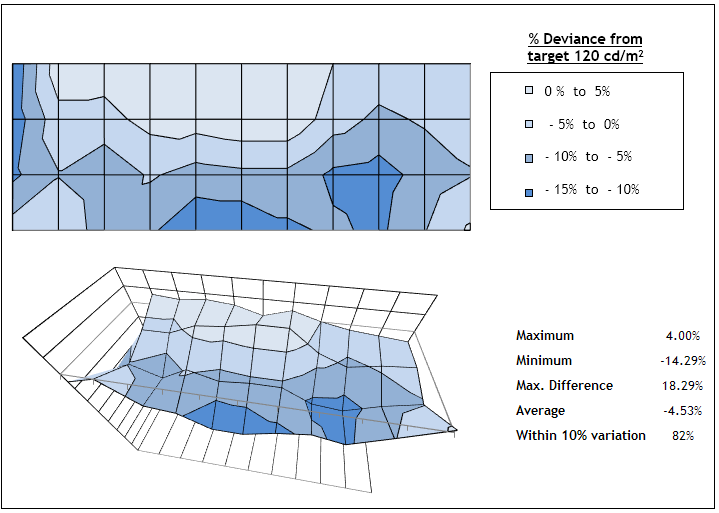
Luminance uniformity of the screen was very good on our sample, with 82% of the screen within a 10% deviance of the centrally calibrated area. Along the left hand edge and bottom area there was a modest drop in luminance down to 105 cd/m2 in the most extreme case.
![]()
Backlight Leakage
Above: All
black screen in a darkened room. Click for larger version
We also tested the screen with an all black image and in a darkened room. A camera was used to capture the result. There were no obvious uniformity issues at all to the naked eye, and the strong contrast ratio left us with a dark and murky black. Capturing this with a camera was tricky as the contrast ratio was strong.
Above: All
black screen in a darkened room. Click for larger version - accentuated by
slower shutter speed to try to capture uniformity more easily
We captured another photo with a slower
shutter speed to try and capture any bleed or clouding in a photo that you might
be able to pick out. There is some very clouding from the lower corners,
particularly in the bottom right,
but it is quite minimal.
Note: if you want to test your own screen for backlight bleed and uniformity problems at any point you need to ensure you have suitable testing conditions. Set the monitor to a sensible day to day brightness level, preferably as close to 120 cd/m2 as you can get it (our tests are once the screen is calibrated to this luminance). Don't just take a photo at the default brightness which is almost always far too high and not a realistic usage condition. You need to take the photo from about 1.5 - 2m back to avoid capturing viewing angle characteristics, especially on IPS-type panels where off-angle glow can come in to play easily. Photos should be taken in a darkened room at a shutter speed which captures what you see reliably and doesn't over-expose the image. A shutter speed of 1/8 second will probably be suitable for this.

General and Office Applications
The Y44w is a different format screen than we've tested in the past, and is an interesting option for office-type work. It has a very wide format which is the equivalent of having 2x 24.7" sized displays with a 1920 x 1200 resolution side by side, but without the border down the middle. 1200 pixels high models of that size have been popular for some time for office work, although not commonly available nowadays. They give you a bit of a vertical resolution boost compared with the mass of 1080p displays available and so it's useful to see that offered here. You get a very wide area in which to work with split screen tasks and the screen curvature also helped ensure this felt comfortable day to day, reducing some of the sharp angles you would experience as you look towards the edges of the display. We have been used to 1440p resolution screens for a long time, so we did notice the slight decrease in vertical area compared with those models. The text size is fairly similar to a 24" screen at 1920 x 1200, being slightly larger then than text on a 27" 2560 x 1440. We found this comfortable for day to day office work, and the clarity was good without the need for any scaling.
The light AG coating of the VA technology panel is certainly welcome, and avoided any grainy appearance from some gaming panels like those featuring TN Film panels. The viewing angles were nice and wide and showed very little colour tone or gamma shift which was pleasing. The screen curve helped a bit here again as you look towards the sides of the screen. There was the normal VA off-centre contrast shift where dark grey detail gets lost in blackness when viewed from head on, only to be revealed as you move your viewing position to the side. This might mean that viewing dark content or doing colour critical work is a little more tricky than on an IPS display.
The out of the box setup was not very good for these kind of uses, particularly with a very high gamma more set up for gaming. Thankfully you can switch to the sRGB mode which is much better, providing a well set up gamma curve and white point. This mode also offers a reliable emulation of the sRGB colour space which might be preferable for these kind of uses away from multimedia and gaming. The only gripe then is the inability to change the brightness level of the screen for some reason once you're using the sRGB mode - just set it to what you like before you enable sRGB to get around that.
The brightness range of the screen was a bit limited for these kind of uses, with the ability to offer a luminance between 446 and 82 cd/m2. This might mean that you are more limited in darker room conditions and low ambient light and for lots of text and office work. Although getting down to 120 cd/m2 will still be adequate for many users. Again, this is a gaming screen and so most people will want the brighter settings for gaming, especially if you are viewing from a further distance as you might well do. We would have just liked to see a lower minimum adjustment for office and general uses ideally.
A setting of 10 in the OSD brightness control should return you a luminance close to 120 cd/m2 out of the box. The brightness regulation is controlled via a flicker free backlight, without the need for Pulse Width Modulation (PWM), and so those who suffer from eye fatigue or headaches associated with flickering backlights need not worry.
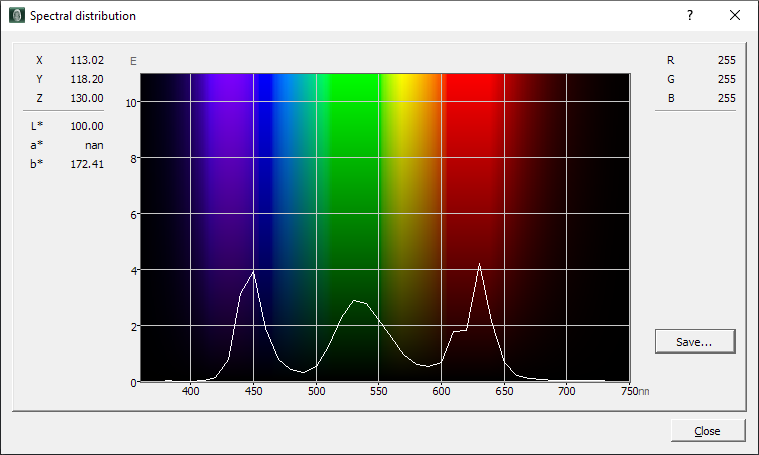
Spectral distribution graph
showing calibrated mode at 6500k
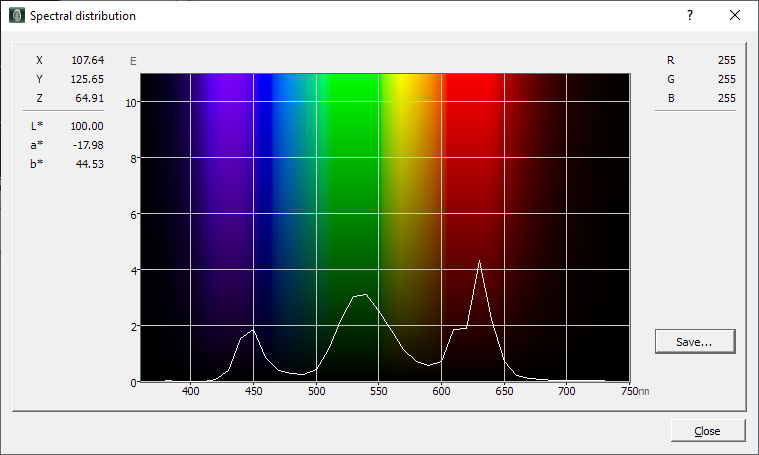
Spectral distribution graph
showing
Blue Light Filter mode ON
There was no audible noise from the screen, even when conducting specific tests which can sometimes cause issues. There is a simple low blue light on/off setting in the OSD which once enabled makes the image much more yellow than our calibrated state. It also then locks all the other controls for brightness, contrast, colour etc, although only at the levels you had them set at before you enabled the blue light reduction mode. We didn't really like the appearance of this mode to be honest, it was too yellow and made it hard to then adjust anything else on the screen without first disabling it.
There are 4x USB 3.1 ports provided on this screen, two on the back and two on the hidden pop-out section on the bottom of the screen for easy-access. There are also no other extras like ambient light sensors, motion sensors or card readers on this screen which are sometimes useful for office-type uses. There is a decent range of ergonomic adjustments from the stand with tilt, height and swivel offered. Height is a bit stiff to operate but on the whole, moving the screen around is fine There is also VESA 100mm mounting capabilities for those who want to mount the screen instead.

Responsiveness and Gaming
|
Panel Manufacturer and Technology |
Samsung SVA (VA-type) |
|
Panel Part |
LSM434YP01 |
|
Quoted G2G Response Time |
4ms G2G |
|
Quoted MPRT Response Time |
n/a |
|
Overdrive Used |
|
|
Overdrive Control Available Via OSD Setting |
Over Drive |
|
Overdrive OSD Settings |
Off, Normal, Extreme |
|
Maximum Refresh Rate |
144Hz |
|
Variable Refresh Rate technology |
AMD FreeSync 2 |
|
Variable Refresh Rate Range |
48 - 144Hz (DisplayPort)
with LFC |
|
Blur Reduction Backlight |
|
The screen uses overdrive technology to boost pixel transitions across grey to grey changes as with nearly all modern displays. The part being used is a Samsung LSM434YP01 SVA (VA-type) technology panel. Have a read about response time in our specs section if you need additional information about this measurement.
We use an
ETC M526
oscilloscope for these measurements along with a custom photosensor device.
Have a read of
our response time measurement article for a full explanation of the testing
methodology and reported data.

Response Times and Refresh Rate
There's various things you need to consider when it comes to response times and gaming, particularly on a display with high refresh rate support. Gaming screens invariably give you a control for the overdrive impulse in the OSD menu which can help you tweak things, but response time performance and overshoot levels can vary depending on the active refresh rate. This behaviour is often different depending on whether the screen is a traditional G-sync screens (with hardware module) or whether it's an adaptive-sync screen as well, and not all screens behave in the same way. We always try to test each variable in our reviews but the key considerations you need to make are:
-
Performance at 60Hz - this is important if you want to use an external games console (or other device like a Blu-ray player etc) which typically run at 60Hz. Response time performance may well be different than at the higher refresh rates supported, and you may need a different overdrive setting for optimal experience.
-
Performance during VRR (Variable Refresh Rate) - bearing in mind that the refresh rate will fluctuate anywhere from 1Hz up to the maximum supported by the screen (e.g. 1 - 144Hz on a 144Hz display). It's important to understand if the response times and overshoot will vary as the refresh rate changes. There may be a need to switch between different overdrive settings in some cases, depending on your usually attained refresh rate output and graphics card capability. This can sometimes become fiddly if your refresh rates fluctuate a lot, especially between different games, so it's always easier if you can leave a display on a single overdrive setting which is suited to the whole range. Some screens also feature "variable overdrive" which helps control the response times and overshoot depending on the active refresh rate. This is particularly apparent with traditional G-sync module screens.
-
Performance at fixed refresh rates including maximum - this is important for those who have a powerful enough system to consistently output a frame rate to meet the max refresh rate capability of the screen. They may want to run at max refresh rate without VRR active, or even is VRR is active they may know they will be consistently at the upper end of the range. Many gaming screens show their optimal response time performance at the maximum refresh rate. Knowing the performance at high fixed refresh rates may also be applicable if you want to use any added blur reduction backlight which typically operate at a fixed refresh rate.
-
Whether the response times can keep up with the frame rate - you will also want to consider whether the response times of the panel can consistently keep up with the frame rate. For instance a 144Hz screen sends a new frame to the display every 6.94ms, so the pixel response times need to ideally be consistently and reliably under this threshold. If they are too slow, it can lead to added blurring in practice and sometimes make the higher refresh rates unusable in real life. We consider this in our analysis.
![]()
|
We carried out some initial response time measurements and visual tests in each of the overdrive settings, and at a range of refresh rates. The overdrive control is available in the OSD menu via the 'Over Drive' option as shown. There are 3 levels available - Off, Normal and Extreme
|
|
144Hz Refresh Rate
We are going to start with 144Hz here which is the maximum refresh rate the screen can support.



We measured each of the modes and you can see that with overdrive Off there was some quite high response times, with an average 11.7ms G2G measured. The familiarly slow black > grey transitions which commonly plague VA panels, shown along the top row of the table where response times ranged up to 35.5ms in the worst case (0 > 50, change from black to dark grey). In practice on VA panels this can lead to some "black smearing" where you get more blurring and smearing on darker content as it struggles to change from black to lighter shades.
Moving up to the 'Normal ' mode brings very little change overall in our measurements and visually. Only by switching up to the 'Extreme' mode do you get some fairly nice improvements. The average response time drops to 8.3ms G2G average and all without any overshoot issues at all which was great news. There's still those problematic slow black > grey transitions that lead to some black smearing because of the VA panel, which can't be cleared up even at the most aggressive overdrive setting. The other response times were impressive though.
100Hz
Refresh Rate


We carried out the same tests but at a lower 100Hz refresh rate as well. At the 'Normal' setting the response times were not much different to at 144Hz really. You could see though that at 100Hz the overdrive impulse seems to be balanced a little differently. In the Extreme mode the average G2G is similar at 8.2ms, but some of them are a little slower than before, but the 0 > 150 transition has been sped up a bit from 17.5ms to 9.0ms. There was also some minor overshoot starting to creep in, so it looks like the overdrive impulse is applied a little more aggressively overall as the refresh rate lowers. This is common behaviour for FreeSync displays.
60Hz Refresh Rate


We also tested the Normal and Extreme modes at 60Hz to consider the optimal setting as refresh rate lowers during FreeSync/G-sync use, or if you want to connect an external 60Hz device like a games console. Again, this shows that as the refresh rate lowers the overdrive impulse is applied a bit more aggressively. You can see in the Extreme mode that there were higher levels of overshoot appearing now, although we still felt this mode was probably optimal at 60Hz and avoided the need to switch between different modes all the time. If you experience any issues with overshoot you may wish to switch to the Normal mode.

Variable Refresh Rates
(VRR)

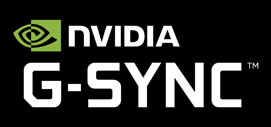
The screen natively supports AMD FreeSync for variable refresh rates between 48 and 144Hz. The screen is also certified under their newer FreeSync 2 scheme, including LFC support and accepting an HDR input signal (more on the HDR capabilities later). AMD FreeSync Technology is supported with DisplayPort and HDMI connections, allowing the screen to be compatible with AMD Radeon Graphics Cards (and modern NVIDIA cards for G-sync), Xbox X, Xbox One, and other future gaming consoles and devices that support FreeSync and Adaptive-Sync.
The screen has not at the time of writing been officially certified under NVIDIA's recent 'G-sync Compatible' scheme, but you can still use it from NVIDIA graphics cards with variable refresh rates just without validated performance levels. It will support VRR over DisplayPort only.
The support for FreeSync and G-sync will be very useful given the significant system demands of running a screen at this high 3840 x 1200 resolution and up to 144Hz refresh rate. It was of course very good to see it included here. We will discuss some of the considerations for using VRR in the following section when it comes to response time performance. You might also want to read our newly updated article about Variable Refresh Rates here.

Detailed Response Times
The response time performance of the Y44w was thankfully quite simple, as you could comfortably stick with the Extreme mode we felt for all refresh rates, including when using VRR (FreeSync / G-sync) and even for fixed 60Hz input sources. There is a chance that you might see a bit of overshoot creeping in at lower refresh rates, so if that's an issue at all you can switch down to the 'normal' mode to eliminate that.
The higher refresh rates really help improve motion clarity and reduce perceived blur, making the screen far better for gaming than 60Hz-only models. The support for VRR from both AMD and NVIDIA systems was welcome as ever, particularly given the high demands of this resolution and refresh rate combination. One other note to keep in mind is the very wide format of this screen (32:10 aspect ratio). You will need to keep in mind support for this aspect ratio from your games if you really want to make the most of the screen area. Where it can be supported this will offer an exceptional wide field of view and quite a unique gaming experience. If it's not supported keep in mind that you will end up with black bars down the side of the image.
Recommended Settings
|
Optimal Refresh Rate |
144Hz |
|
Optimal Overdrive Setting (for above) |
Extreme |
|
Optimal Overdrive Setting for 60Hz |
Extreme |
|
Optimal Overdrive Setting for VRR |
Extreme |
144Hz, Over Drive Extreme


We carried out some further response time
measurements at 144Hz. The screen behaved fairly typically for a VA technology
panel, and one using FreeSync as well. There was some issues with black > grey
transitions which affect nearly all VA panels we've tested leading to some black
smearing in some content. You can see those problematic transitions along the
top row of the response time measurements. Apart from those the response times
were overall pretty good, and we measured an average of 6.9ms G2G if we ignore
those slow VA transitions. Because some transitions were quite slow, it did mean
that only 70% of the measurements were within a sensible limit for the 144Hz
refresh rate, so you do sometimes get some added motion blur in practice where
they can't keep up quite with the frame rate demands. Thankfully even at the
maximum 'Extreme' mode there was no real overshoot at 144Hz, with only one
transition from white to light grey causing an issue in these measurements. It
was these transitions where the response times were driven the lowest, down to
an impressive 1.5ms in fact in the best case.

Gaming Comparisons
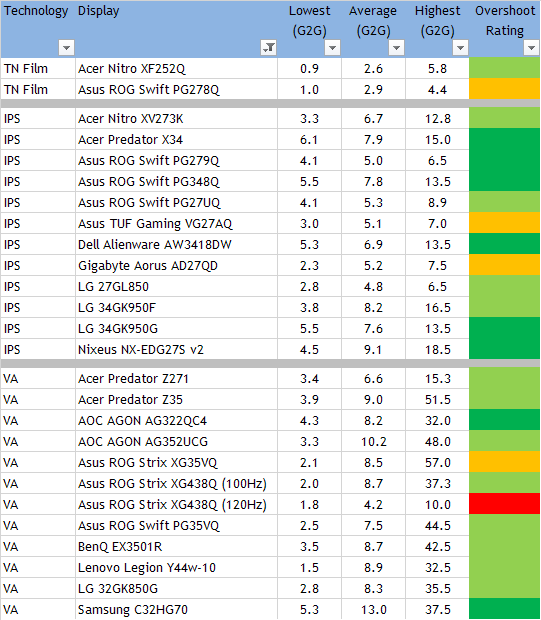
We have provided a comparison of the display against many other gaming screens we have reviewed in a similar size range and across a range of panel technologies. This table is now split by panel technology to make life a bit easier and for quicker comparison. The Y44w was fairly typical for a high refresh rate VA panel to be honest.
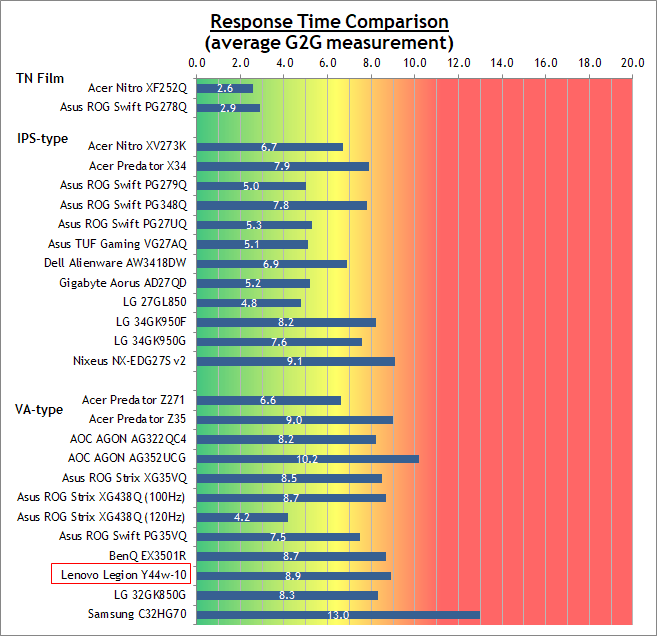
VA Technology Display Comparison
To try and give a more direct comparison between the different VA models we've tested we have produced the following new comparison table below. Each screen is set to the optimal response time setting and refresh rate from our reviews.
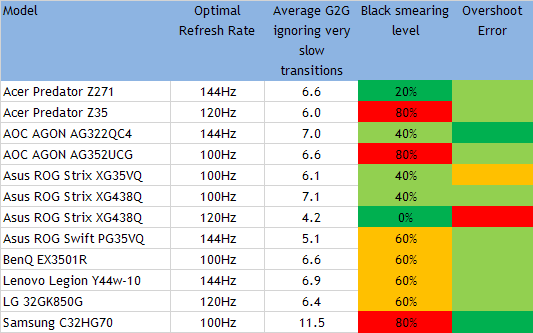
You can see that the Y44w is fairly typical
in its level of black smearing at 60%, sitting somewhere in the middle of the VA
models we've tested to date. Thankfully it does have low levels of overshoot
which is good news.
![]()
To explain the "black smearing" measurement above. The higher the black smearing level (as a %), the worse the screen is in this regard. The "Black smearing level" is determined by looking at the response times along the top row of our measurements which are those changing from black (0) to various grey shades (50, 100 and 150 levels) and white (255).
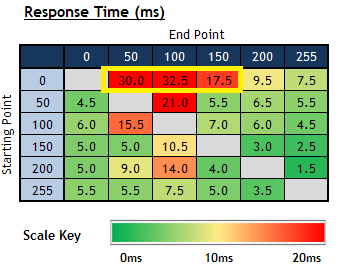
If we take the response time measurements from the Y44w here at 144Hz there are 3 transitions which are particularly slow (anything above 15ms is considered too slow) and problematic so in this example 60% of the black transitions are slow here (3 out of 5). If a screen has 4 very slow transitions its black smearing level would be 80% and so on.

Additional
Gaming Features

-
Aspect Ratio Control - the screen has a wide range of hardware aspect ratio controls to account for other formats than the rather unusual 3840 x 1200 32:10 aspect ratio of the display. There are modes for full screen, original aspect ratio, 1:1 pixel mapping, 17" (4:3), 19" (1:1), 19" (16:10) and 21.5" (16:9) available. Useful to see standard options to keep the source aspect ratio and also a 1:1 pixel mapping modes in particular.
-
Preset Modes - There are a few different preset modes aimed at gaming that can be customised and used if you want. This includes modes for FPS 1, FPS 2, Racing, RTS, and 2 user modes you can save how you want.
-
Refresh Rate Number - there is a simple setting in the menu that enables a refresh rate counter on the screen if you want to monitor that in games. It can be positioned in each of the four corners.

Lag
Read our detailed article about input lag and the various measurement techniques which are used to evaluate this aspect of a display. The screens tested are split into two measurements which are based on our overall display lag tests and half the average G2G response time, as measured by our oscilloscope. The response time element, part of the lag you can see, is split from the overall display lag and shown on the graph as the green bar. From there, the signal processing (red bar) can be provided as a good estimation of the lag you would feel from the display. We also classify each display as follows:
Lag Classification
-
Class 1) Less than 8.33ms - the equivalent to 1 frame lag of a display at 120Hz refresh rate - should be fine for gamers, even at high levels
-
Class 2) A lag of 8.33 - 16.66ms - the equivalent of one to two frames at a 120Hz refresh rate - moderate lag but should be fine for many gamers. Caution advised for serious gaming
-
Class 3) A lag of more than 16.66ms - the equivalent of more than 2 frames at a refresh rate of 120Hz - Some noticeable lag in daily usage, not suitable for high end gaming

For the full reviews of the models compared here and the dates they were written (and when screens were approximately released to the market), please see our full reviews index.
|
|
At 144Hz the total lag measured was a very impressive 4.20 ms. With around 3.45ms of that accounted for by the pixel response times (using the Extreme overdrive mode for this test and taking the average G2G ignoring the particularly slow black > grey transitions) we can calculate a signal processing lag of only 0.75ms, which was next to nothing. An impressive result from this display and making it suitable for fast and competitive gaming. At 60Hz the lag was basically the same which was again pleasing.

Movies and Video
The following summarises the screens performance for videos and movie viewing:
|
Category |
Display Specs / Measurements |
Comments |
|
Size |
43.4" super wide |
Very large for a desktop monitor currently, although a more unusual format given it's very wide size |
|
Aspect Ratio |
32:10 |
A lot of content and devices might not be set up for this very wide format, and so you may end up with black bars down the right and left hand sides, particularly for common 16:9 input sources |
|
Resolution |
3840 x 1200 |
Can support native 1080p content but not Ultra HD 4K natively |
|
HDCP |
Yes |
Suitable for encrypted content |
|
Connectivity |
1x DisplayPort 1.4, 2x USB type-C and 2x HDMI 2.0 |
Useful additional 2x HDMI input for external Blu-ray players or games consoles |
|
Cables |
DisplayPort and HDMI |
Both DisplayPort and HDMI provided which is useful |
|
Ergonomics |
Tilt, height, swivel |
Good range of ergonomic adjustments to obtain a comfortable viewing position. Stand is very sturdy and strong |
|
Coating |
Light Anti-glare |
Provides clear, non-grainy image and avoids unwanted reflections of full glossy solutions |
|
Brightness range |
82 - 446 cd/m2 (SDR) |
Lots of range in the upper brightness end relative to many modern displays, but a little limited at the lower adjustment range if you are watching in darker room conditions. Although given your likely further viewing position, this is likely to be fine for gaming and movies. Flicker free backlight operation with no PWM. HDR discussed in a moment. |
|
Contrast |
2377:1 after calibration |
Very good VA contrast ratio which should still be great for dark content and HDR, and offering good shadow detail. |
|
Preset modes |
None |
There is no specific movie or video preset mode but you can customise one of the other modes like Game 1 or 2 perhaps |
|
Response times |
8.9ms G2G at 144Hz with no overshoot 8ms G2G at 60Hz with some moderate |
Response times are good at higher refresh rates although with no overshoot which was great. For movies and particularly external Blu-ray players it's the 60Hz performance that is most important and this is pretty decent. Good enough response times and fairly low levels of overshoot (Extreme mode), although there's some characteristic VA black smearing in places on moving content. |
|
Viewing angles |
Good |
Not as wide as IPS, and fairly typical for a VA panel. Free from the pale "IPS-glow" on dark content when viewed from an angle that you see on IPS panels but do suffer from the black crush when viewed head on. May lose some detail in darker scenes as a result |
|
Backlight bleed |
No major bleed |
Some slight clouding in the corners on our sample but nothing really noticeable at all |
|
Audio |
Headphone output |
Fairly decent detachable speaker provided in the box with this model which are probably fine for general console gaming and some movies and YouTube videos. There is also a headphone jack provided in the hidden pop-out section on the bottom edge of the screen |
|
Aspect Ratio Controls |
Many options available including source aspect ratio and 1:1 mapping |
Good range of aspect ratio controls which will be useful given the unusual native 32:10 format of this display, and the fact many external devices will be 16:9. You may end up with black bars down the left and right hand sides as a result in many situations |
|
PiP / PbP |
Both supported |
Both available in a range of configurations |

HDR (High Dynamic Range)
|
HDR Capability Summary |
HDR Technical Capabilities |
|||
|
VESA DisplayHDR Certification level |
HDR 400 |
|
Local Dimming |
No |
|
Certified to the rather meaningless HDR 400 standard which does not require any form of local dimming and so cannot offer improved dynamic range/contrast. There is at least a wide colour gamut and 10-bit colour depth, and the VA panel offers fairly decent static contrast ratios. |
|
Increased dynamic range (contrast) |
n/a |
|
|
|
Increased peak brightness |
512 cd/m2 |
||
|
|
Wide DCI-P3 colour gamut |
89.9% |
||
|
|
10-bit Colour Depth |
8-bit + FRC |
||
The screen can take an HDR input signal but has no local dimming capability, so cannot truly offer an improved dynamic range. It has a peak brightness of >400 cd/m2 so carries the rather meaningless HDR400 certification. We activated HDR mode and measured a peak brightness of 512 cd/m2, which extended a little beyond the 446 cd/m2 maximum we'd measured in SDR normal mode. With the HDR mode activated you lose access to most of the OSD settings, including the overdrive control which seems to operate a little slower than the Extreme mode we'd been using in SDR mode. There was a bit more blurring to moving content.
The screen does at least have the extended DCI-P3 colour space and 10-bit colour depth support for improved colours in HDR content so you will benefit from enhanced colours for this kind of content. You just won't benefit from any improvements to the active contrast ratio of the image.

Conclusion
If you enjoy our work and want to say thanks, or would like to get early access to future reviews please consider becoming a TFT Central supporter.
This is the first super-wide format screen we've tested beyond the more common 34 - 35" 21:9 ultrawide displays and it was an interesting experience. It's a little tricky to know exactly where its niche is to be honest. The screen is marketed as a gaming screen so let's focus there first. The high refresh rate support up to 144Hz and the inclusion of FreeSync and G-sync support is of course very beneficial. The high refresh rate helps to improve motion clarity in gaming and support higher frame rates while the FreeSync/G-sync support helps account for variable refresh rates and cope with the demand that the high resolution and refresh rate will have on your system. Lag was non-existent which was also excellent news. Response times were fairly typical for a VA panel to be honest. Thankfully you don't need to worry about fiddling around with the overdrive mode and there was very low levels of overshoot as well. Being a VA panel there are some usual slow black > grey transitions resulting in familiar VA black smearing in some moving content.
The question we have about gaming on this screen is really down to the aspect ratio and super-wide format. If you can find a game that supports this format then no doubt it will be very immersive and enjoyable, it just feels like a lot of the time you may be left using the screen in a more common aspect ratio and living with black borders down the sides. This kind of defeats the purposes of having such a wide format when it comes to gaming, although the option is at least there. The super-wide format does then at least afford you some interesting options for other day to day work.
When it comes to more day to day work, the super-wide format is very useable and the equivalent of having two 1920 x 1200 24.7" models side by side, without the annoying border down the middle. The resolution was sensible for the screen size and text clarity was good. Multi-tasking and split screen work is very enjoyable and there's plenty of horizontal room to play with. Unfortunately there were a few issues though for these kind of uses. The default setup of the screen was aimed at gaming, and poorly configured for other normal uses. The gamma was the main problem and without any gamma settings in the OSD it was hard to correct. Thankfully there is a well set up sRGB mode which offers a more reliable gamma, white point, improved contrast ratio, good colour accuracy and a reliable sRGB colour gamut emulation. That's your best option for normal uses, we would have just liked to see more flexibility in the native gamut modes really. Colour banding was the main issue with the screen affecting darker shades even after calibration and in all the preset modes. Along with the usual off-centre viewing angle limitations of the VA panel technology this makes it not very well suited to any colour critical work. Day to day general and office type uses, no real issues. The VA panel technology provided very strong contrast ratios which are far beyond competing TN Film and IPS options, and an obvious strength of this technology. We were pleasantly surprised also by the better-than-usual viewing angles provided from the Samsung VA panel here.
If you're after a super-wide screen for
productivity and as a replacement to dual screen setups, it's well worth a look.
|
Pros |
Cons |
|
Super wide format replaces dual 24.7" screens with a high resolution for great multi-tasking |
Some typical VA response time challenges and black smearing in some cases |
|
High refresh rate, VRR support and very low lag |
Poor default setup and tricky to correct gamma |
|
Strong contrast ratio and particularly decent viewing angles for a VA panel |
Colour banding issues |
|
Check Pricing and Buy - Affiliate Links |
|
TFTCentral is a participant in the Amazon Services LLC Associates Programme, an affiliate advertising programme designed to provide a means for sites to earn advertising fees by advertising and linking to Amazon.com, Amazon.co.uk, Amazon.de, Amazon.ca and other Amazon stores worldwide. We also participate in a similar scheme for Overclockers.co.uk. |



